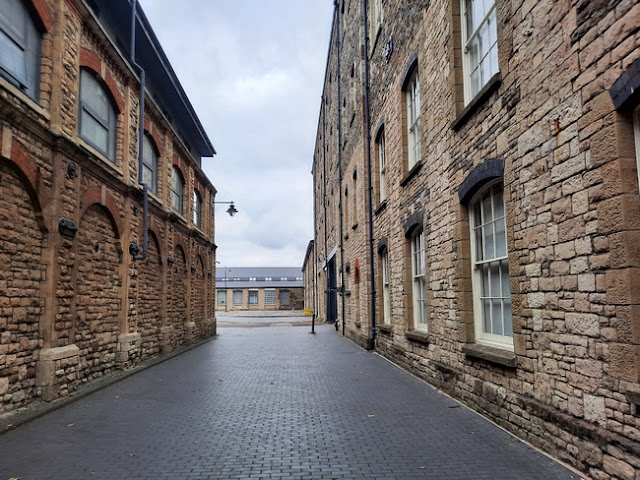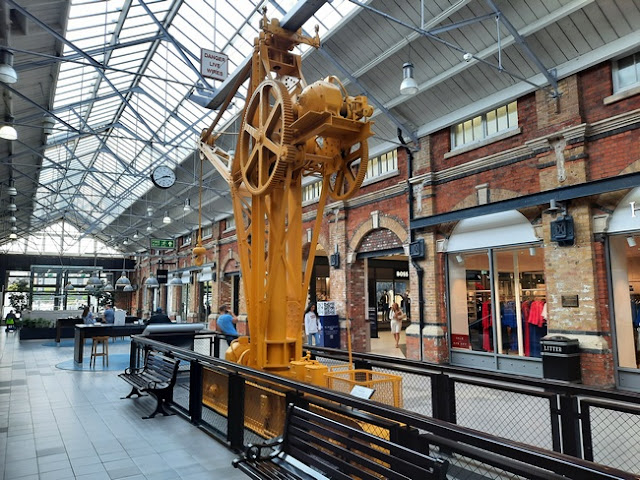A short walk around the Swindon Works site from Swindon Station
The first buildings of Swindon Works were completed in 1841. Prior to the construction of the works the site was a green field site chosen as a sensible location for changing engines on the run between London and Bristol. Swindon is closer to Bristol than London but the terrain was more challenging between Bristol and Swindon than between Swindon and London. The works brought most of the Great Western Railway's engineering in house. It continued to build and maintain locos and carriages for British Railways, though the former LMS works of Crewe and Derby tended to be more highly favoured after nationalisation. In 1986 the works was closed. Many of the oldest buildings of the works survive as the home of Steam, the museum of the GWR, and the Designer Outlet retail park as well as offices for English Heritage, Historic England and other organisations.
Below - A map of the works from a 1979 open day brochure found on Flickr.
The former works is a short walk from Swindon station.
Below - The station at Swindon with the former British Rail Western Region offices above.
Below - The former carriage works on the south side of the mainline seen from the station car park.
Below - An information board on the former carriage works.
1886 Map
As well as providing the main engineering facility for the GWR the company also established an entire town for its workers with all the amenities they would need. In fact Nye Bevan gave Swindon as an example of having an ideal health service, the NHS being described as scaling up what was available in Swindon to the rest of the country.
Below - Former housed for the works workforce.
Below - The Mechanics Institute contained some of the key amenities such as health care and a library. Since the closure of the works it has been allowed to fall in to dereliction despite its Grade 2* listed status.
Below - Opposite the Mechanics Institute a subway allowed workers to walk in to the works complex beneath the mainline and some of the buildings on the south side of the mainline.
Below - The entrance to the subway from the works side.
Below - One of the works buildings which does not seem to have found a new use, it still carries a sign showing it as a training centre.
Below - The passageway between works buildings after emerging from the subway. On the above 1979 map the building on the left in the first photo is the DMU and Carriages shop and the one on the right is the offices.
Below - The former works offices, now home to English Heritage and the Historic England Archive.
Below - A traverser used to move vehicles between parts of the works.
Below - Churchward House, its use isn't shown on the above map but it looks to have been more offices.
Below - The building on the right is shown on the old map as the wheels and bogie shop. It is now the Steam museum.
Below - The front of the Steam museum building.
Below - A foundry reconstruction in the Steam museum.
Below - A reconstruction of a scene from the carriage works.
Below - A workshop reconstruction with various machines driven by line shafts.
Below - GWR 4248 displayed as if it were under construction. The engine was built in 1916 when women would have filled some of the jobs in the works to cover for men serving in the First World War.
Below - Caerphilly Castle displayed with the Cheltenham Flyer headboard, the prestigious Worlds Fastest Train of the time.
Below - Of course when the works was started the locomotives were of the 7ft broad gauge used on the Great Western Railway. This replica of North Star was built in 1925 using some original parts. For many years it was displayed in the works.
Below - The last Great Western Railway loco built at Swindon in 1947 before the railways were nationalised. Many locos were built for British Railways, including Evening Star, the last mainline steam locomotive for British Railways.
Below - The flagship of the GWR, the King Class, 6000: King George V.
Below - City of Truro, claimed to be the first locomotive to achieve over 100mph, though this was not authenticated with a Dynamometer Car like subsequent record runs by the LMS and LNER.
Below - 2818, one of the heavy freight 2800 Class locos.
Below - A glass fronted office and clock overlooking the shop floor. This would likely have housed offices overseeing the shop floor staff.
From Steam we went to the Designer Outlet which repurposed many of the other works buildings and retained many original features.
Below - Shown on the map above as Brakes in the foreground and Saw Mill in the background. Note the whistles on the roof that would have been sounded for shift changes. This location would have been fairly central in the works site but over the years the works expanded along the railway line towards Bristol.
Below - The building shown as Saw Mill.
Below - A set of wheels on display as a reminder of the history of the site.
Below - Better still as a reminder of the history of the site, a complete engine, Ditcheat Manor. The engine has been changed and will probably change again when the time comes to return Ditcheat Manor to working condition.
Below - A weighing machine, one of a number of pieces of machinery dotted around the Designer Outlet.
Below - A look along what was the Engines & Transmissions Shop in later days.
Below - More pieces of workshop machinery displayed in the retail complex.
Below - A crane that would have been movable using rails above and below.
Below - A few overhead cranes can be seen by looking up occasionally around the shops.
I exited the retail park towards the West Car Park which is built on a mostly cleared part of the works complex. It can be seen where Rodbourne Road passed through the site.


Below - The former Pattern Store, now a church, with the water tower on top. The track towards the turntable is now set in to the tarmac of the car park.

Below - A surviving turntable, once restored as a feature on the edge of the car parking but seemingly a bit forgotten now and fenced off with wire fencing panels.


West of here the later extensions of the works site have been mostly flattened and redeveloped with housing. Though a large perimeter wall survives between the backs of the houses on the original Redcliffe Street and those built on the former works site. A stretch of the wall can be seen on Penzance Drive. Another surviving building is "Harper's Steakhouse and Bar at the Weighbridge", a former building alongside the railway now converted to a restaurant. I didn't venture that far though, instead returning to Swindon station.



















































No comments:
Post a Comment